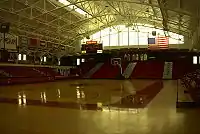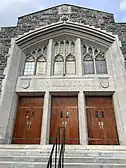Rose Hill Gymnasium
Rose Hill Gymnasium is a 3,200-seat multi-purpose arena on the Rose Hill campus of Fordham University in The Bronx, New York City, New York. The arena, which opened in 1925, is the oldest on-campus venue currently used primarily for an NCAA Division I basketball team[1] and the second-oldest overall (with the oldest being Northeastern University's Matthews Arena, opened in 1910 and currently used for its basketball and hockey teams). volleyball team of Fordham University also uses the gym. The Rose Hill Gymnasium has a gothic facade in keeping with the rest of Fordham University's buildings. The interior design features two high-tech video boards, bleachers that surround all four sides of the court, and additional elevated seating along the court. ESPN named this gym one of the four “cathedrals” of college basketball.[2] At the time it was built, it was one of the largest on-campus facilities in the country, earning it the nickname "The Prairie." The Rose Hill Gymnasium has been the site of many legendary college and high school basketball games, including the final high school game of Lew Alcindor, later known as Kareem Abdul-Jabbar. During World War II, it was also used as a barracks. New York City Mayor Ed Koch lived in these barracks for a time. As early as 1970 an effort headed by famed Fordham alumnus Vince Lombardi was made to build a new arena. This effort ended with Lombardi's death and the move of head basketball coach "Digger" Phelps to the University of Notre Dame.[3]
"The Prairie" | |
 | |
| Location | Fordham University Bronx, NY 10458 |
|---|---|
| Coordinates | 40.862148°N 73.883824°W |
| Public transit | |
| Owner | Fordham University |
| Operator | Fordham University |
| Capacity | 3,200 (basketball and volleyball) |
| Surface | Hardwood |
| Opened | January 16, 1925 |
| Tenants | |
| Fordham Rams (basketball and volleyball) | |
Architectural style
Some of the features that display the gothic revival architectural style include:
Arches: The entrance doors to the gymnasium are under one pointed arch. There are also six windows with a similar shape above the main doors.

Buttresses: There are a few buttresses around the windows for exterior support.
Stone-like materials: The main entrance is surrounded by stone and stone carvings.
Parapets with crenellations: There is a small wall, or parapet, that exceeds the edge of the gym's roof and it has cut outs, or crenellations, which were used as fortification in Medieval Castles.
Sculpture elements: Above the main arch to the entrance there is a stone sculpture of a cross and Fordham's emblem.
Tracery: There are ovals and other shapes carved in stone on the windows.
Walls: The exterior front walls are made of rough light field stones.[4]

History
The Gymnasium hosted its first basketball game on January 16, 1925.[5] The game was refereed by Frankie Frisch, a Fordham alumni and New York Giants' second baseman.
During World War 2, this gym was used as a U.S. army barracks to shelter the soldiers and separate them from the general public. On May 11, 1946, President Harry Truman visited this barrack and rang a ship bell that still remains there today. Fordham athletic teams continue to ring this bell after conference championship wins.
Renovations
The Rose Hill Gymnasium was almost renovated in the early 1970s. Vince Lombardi, a Fordham football alumni, wanted to transform the small gym into a 10,500-seat gym. This plan fell through when Lombardi died in 1970 and the head basketball coach Digger Phelps left Fordham for Notre Dame in 1971. Instead, Fordham University built a separate athletic facility that was attached to the gym.[6]
In 2018, the Rose Hill Gymnasium basketball court was renamed the Frank McLaughlin Family Basketball Court after alumnus Frank McLaughlin, who was a basketball player (1965–1969), assistant coach (1970–1971), and athletic director (1985–2012) for Fordham University.[7]
In 2019, Caldwell & Walsh Building Construction Inc. renovated the gym floors from old wood to a modern shock-absorbing material. The renovation was completed in a four-and-a-half-month period.[8]
References
- "Mag: Yale, Bulter among nation's oldest basketball stadiums". ESPN.com. Retrieved 2017-06-16.
- Hanson, Dave (2015-11-26). "Rose Hill Gymnasium – Fordham Rams". Stadium Journey. Retrieved 2021-04-08.
- At Fordham, Gym Has History if Not Allure
- "Glossary - Loyola's Historic Architecture - Department of History - Loyola University Maryland". www.loyola.edu. Retrieved 2021-04-09.
- "Mag: Yale, Bulter among nation's oldest basketball stadiums". ESPN.com. 2011-11-07. Retrieved 2021-04-08.
- Krupnick, Matt (2014-03-11). "At Fordham, Gym Has History if Not Allure". The New York Times. ISSN 0362-4331. Retrieved 2021-04-08.
- "Rose Hill Gym to be Renovated, Renamed". The Fordham Ram. 2021-01-18. Retrieved 2021-04-08.
- "Basketball Court Renovation Nears Completion". Fordham Newsroom. 2019-09-24. Retrieved 2021-04-09.




